Yule has been and gone for this year, celebrated with friends, a delicious feast and the burning of the Yule Log (Ashen Faggot in our household). What a lovely way to celebrate midwinter!
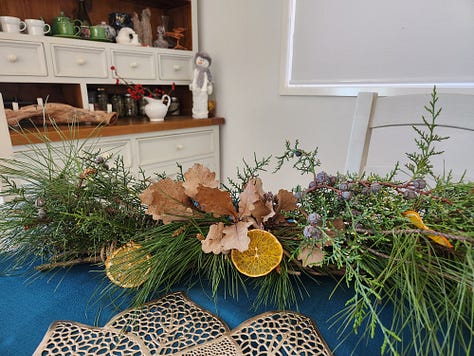
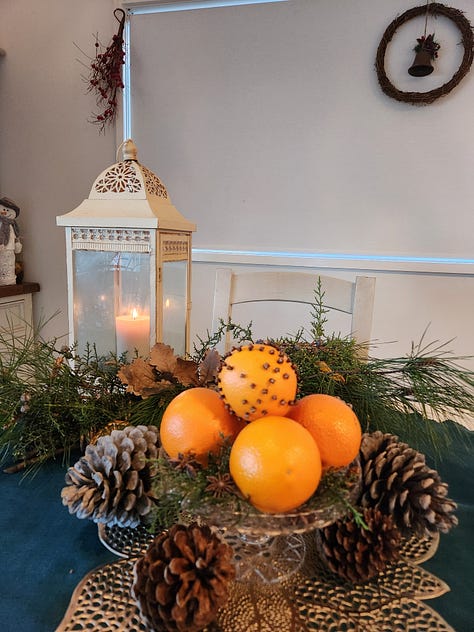
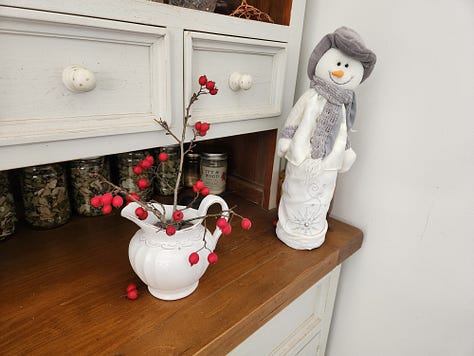
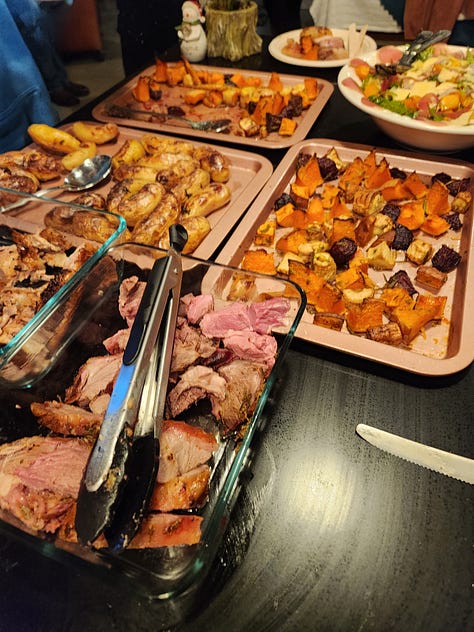

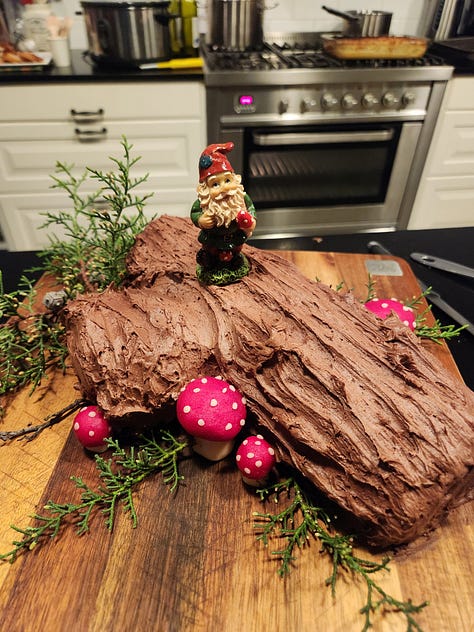
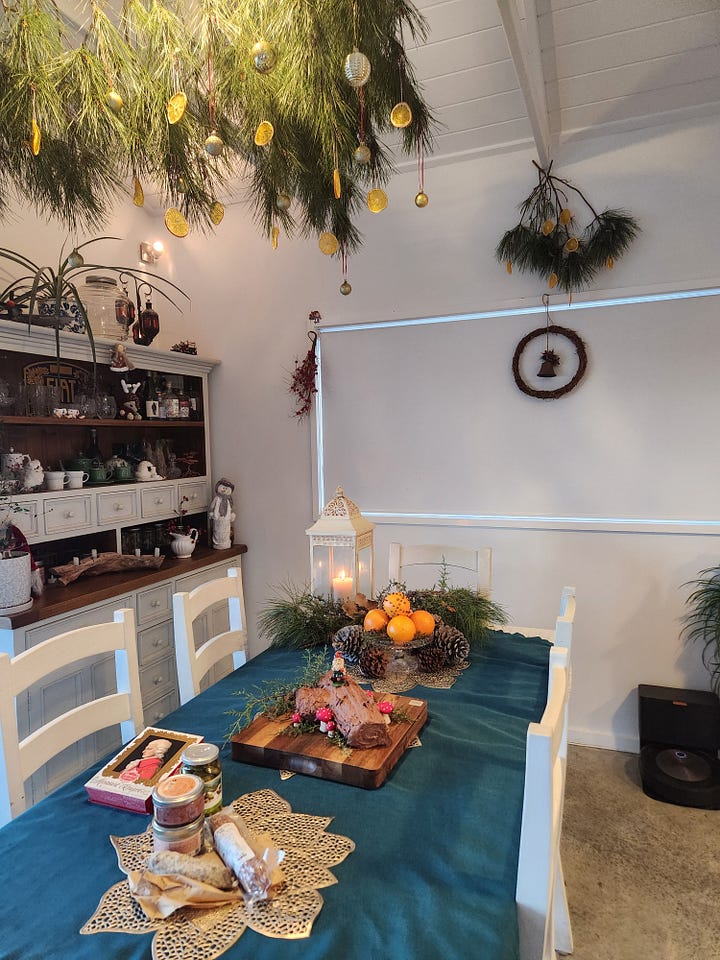
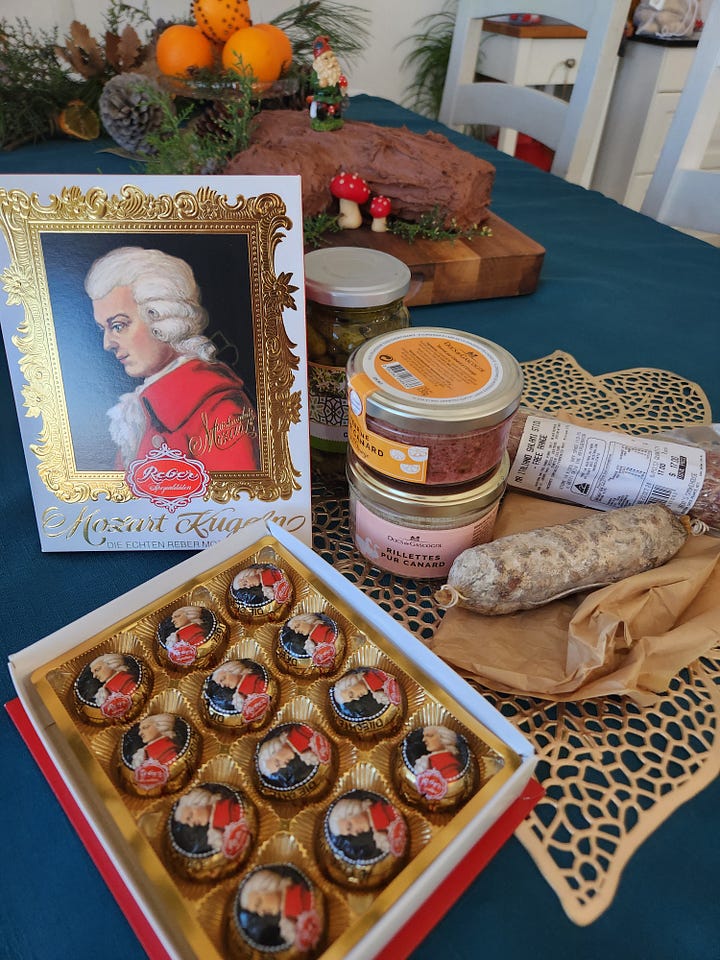
Before we end this year’s Yule season, let’s explore the fascinating creatures that inhabit Scandinavian Yule folklore and folktales: the charming Tomte/Nisse, the fascinating Julbok (Yule Goat), the nasty Yule Troll and her thirteen Yule Lads, and the terrifying giant Yule Cat.
Nisse/Tomte
The Nisse, also known as the Tomte, is a beloved figure in Scandinavian folklore, deeply woven into the traditions and celebrations of the Yule or Christmas season. This mythical creature is often depicted as a small (60–90 cm), elderly man, often with a white beard, and wearing traditional Nordic farmers’ clothing, including a pointed hat, tunic and boots.

According to Scandinavian legend, the Nisse is a magical being who resides on farms and in rural areas and is believed to be the guardian of the homestead and its inhabitants. In Norway, Denmark, and parts of Sweden, he is typically known as the Julenisse or Jul Nisse, during the Yule season. The word nisse is derived from the Old Norse word nis or niðsi, which refers to a domestic spirit or household guardian, similar to the Scottish and English brownie, and means “dear little relative.” In Sweden, he is known as the Tomte and some in parts of Finland as the Tonttu, from the Swedish word tomt (tontti in Finland), which means “plot of land” or “homestead.”
Midwinter’s nightly frost is hard —
Brightly the stars are beaming;
Fast asleep is the lonely yard,
All, at midnight, are dreaming.
Clear is the moon, and the snow-drifts shine,
Glistening white, on fir and pine,
Covers on rooflets making
None but the Tomte is waking
Victor Rydberg (1881)
The Nisse is a mischievous and benevolent character, known for his playful antics and acts of kindness… if he is respected and if the farm, homestead, animals and children are well tended. He is said to assist with farm chores, tend to the animals, and protect the household, especially the children.
However, he is also known to be easily offended and can bring bad luck if he feels neglected or disrespected, if the farm chores are not done, or if the animals or children are mistreated. He’s been known to tie cows’ tails together, sour the milk, turn things upside down, break things, and even give disrespectful farm workers a thrashing.
During the Yule season in Scandinavia, it is customary for families to leave out a bowl of porridge or other treats as an offering to the Nisse, hoping to receive his blessings for a bountiful year ahead. If the Nisse was not given his bowl of porridge with a pat of butter on top, he would become so offended that he left the household or ruined the farm’s fortune.
This short and sweet video (1:20 mins), included in a previous article Winter Feast, features the Norwegian Nisse and the tradition of leaving him rice porridge with butter for Yule.
In some modern Scandinavian traditions, families leave out a special seat or corner for the Nisse by the hearth, where he can rest and enjoy his treats. Children often write letters to him, expressing their wishes for Christmas gifts or simply thanking him for his watchful presence.
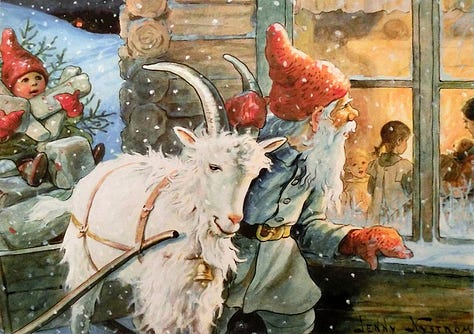

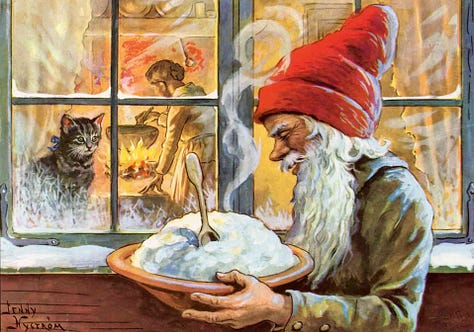
The Nisse/Tomte was originally associated with the spirit of the land and fertility. Belief in them remained strong, especially in rural areas, even as Christianity spread throughout Scandinavia, claiming that the Nisse/Tomte were in fact, the Devil. Eventually, the Nisse absorbed some of the attributes of Santa Claus, including the colours of red and white and he became the gift giver at Yule or Christmas.
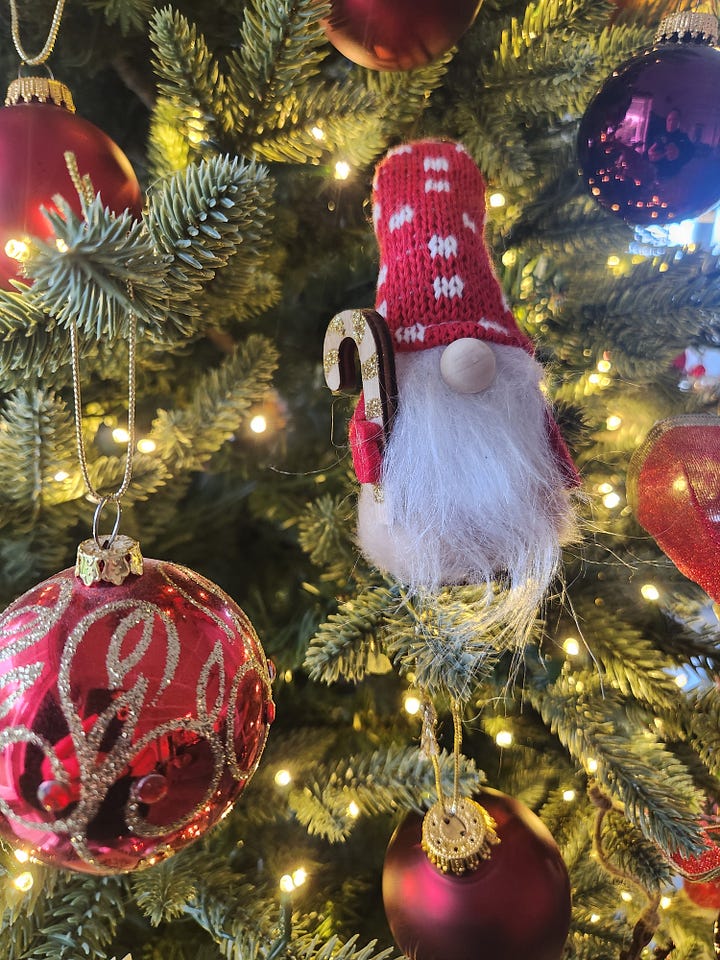
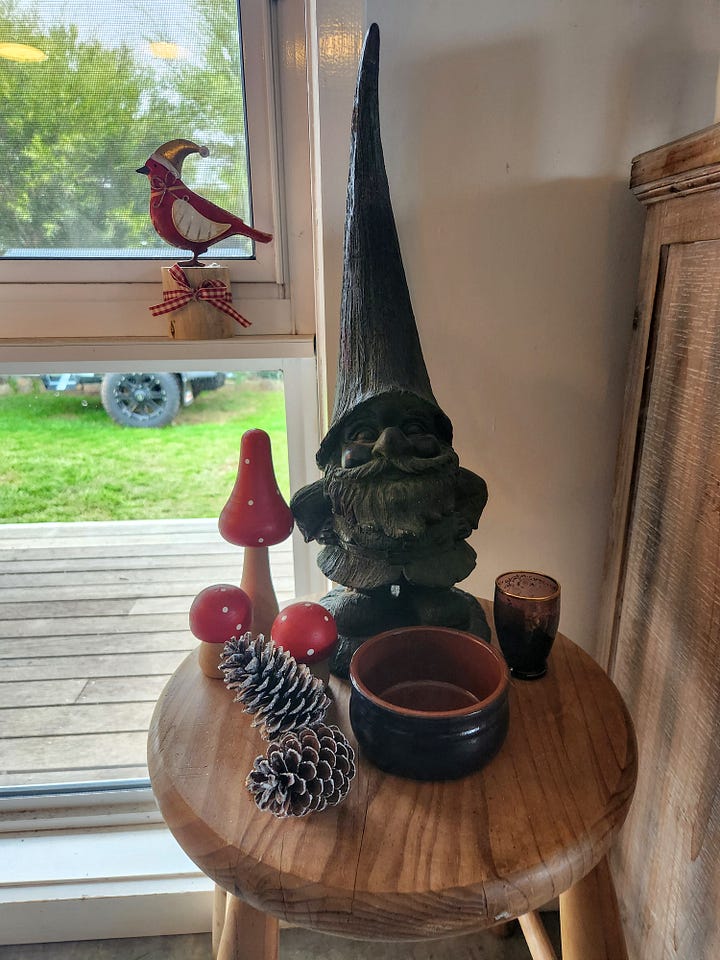
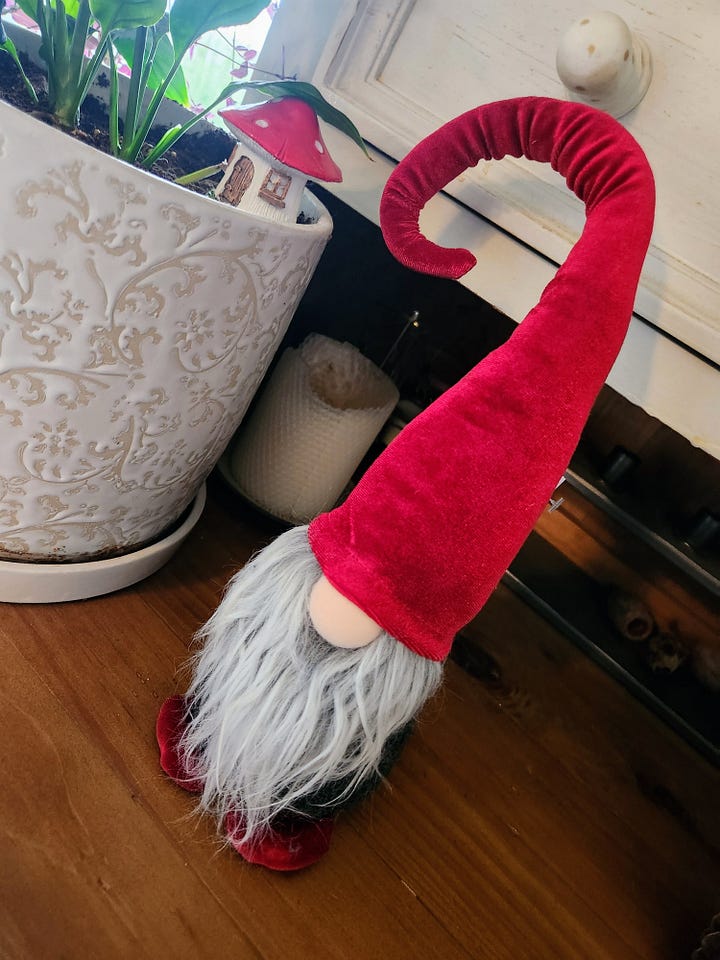
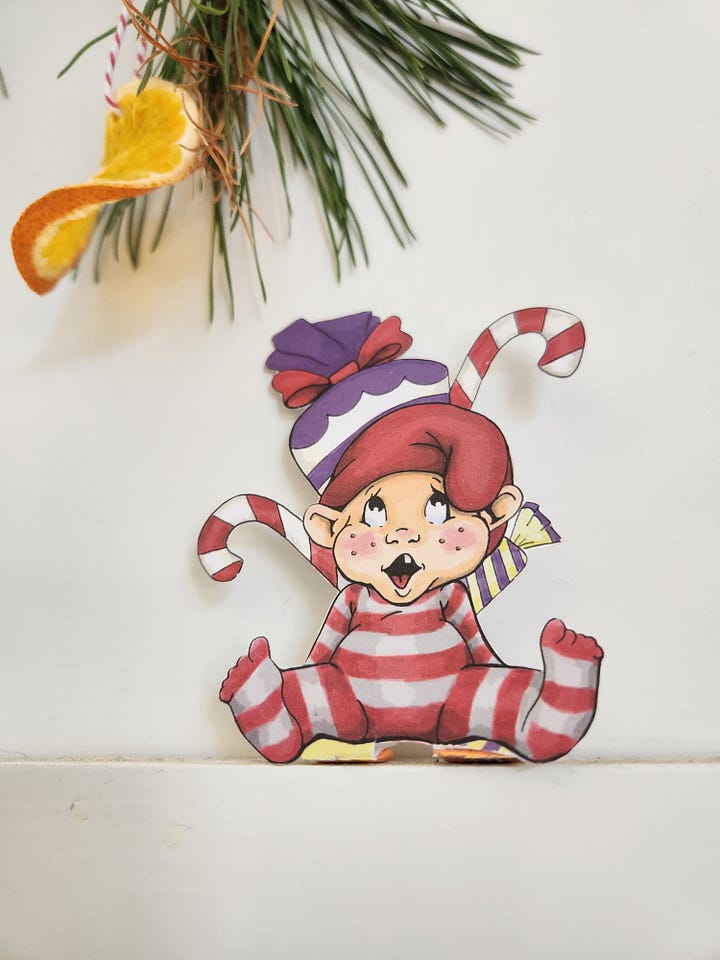
Astrid Lindgren, Swedish writer and author of the famous children’s book series, Pippi Longstocking, wrote several charming books about the Tomten, including The Tomten and The Tomten and the Fox. The Tomte also features in another Scandinavian Yule classic, The Yule Tomte and the Little Rabbits.
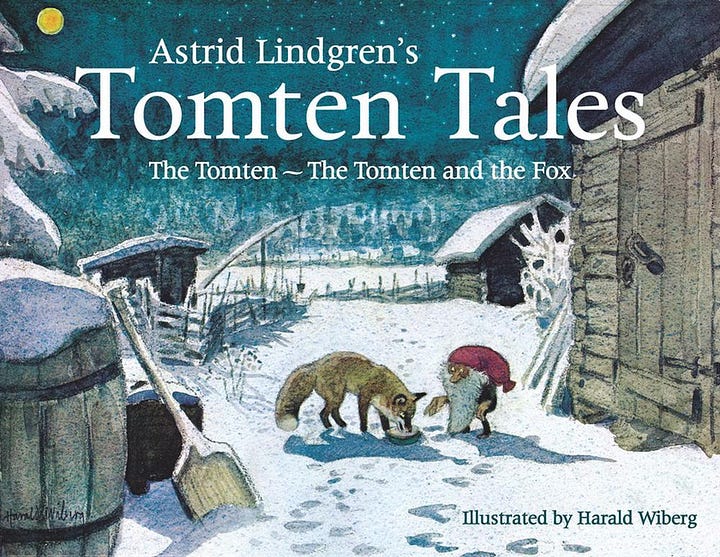

I thought it might be fun to share some of the Nisse-themed Yule carols that I love playing from the start of June until the end of Yule in July. The first one is a Swedish carol called På låven sitter nissen (1:25 mins) about mice trying to steal the Nissen’s porridge. The second one is a popular Finnish Yule carol, the Nisse Polka. The third one is my favourite, Tomtarnas Julnatt, also called the “Tip Tap Song” (you’ll see why when you listen) and I’ve included three versions, the Swedish version with animation, an English version, and a sweet home-video (3:12 mins) of Finnish children singing and dancing to their version called Tonttujen jouluyö. I hope you enjoy them as much as I do!
På låven sitter nissen
Nisse Polka
Tomtarnas Julnatt
The Tomte/Nisse is a ubiquitous icon of the Scandinavian Yule season and I love their charming presence amongst my household’s Yule decorations.
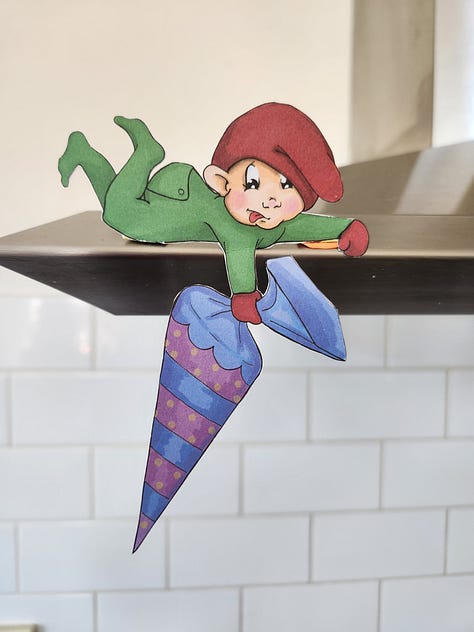
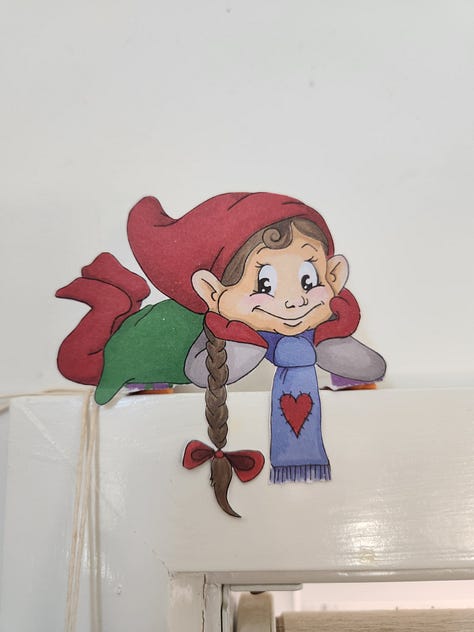

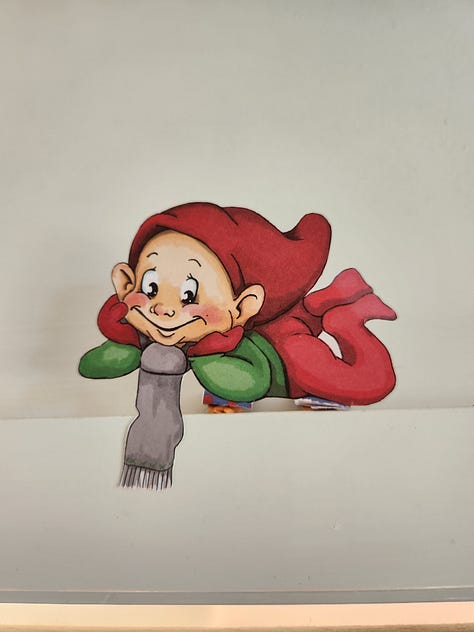
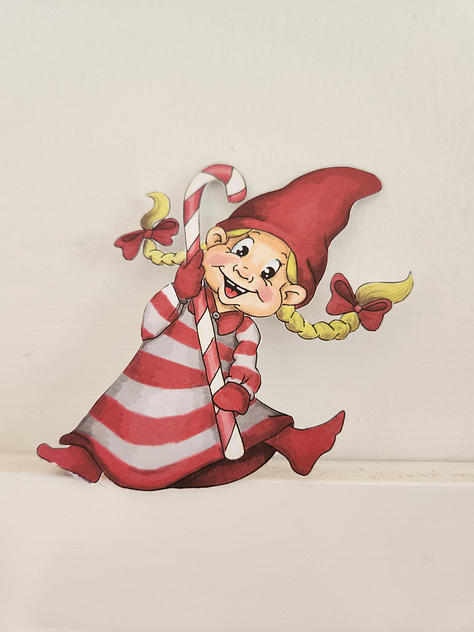
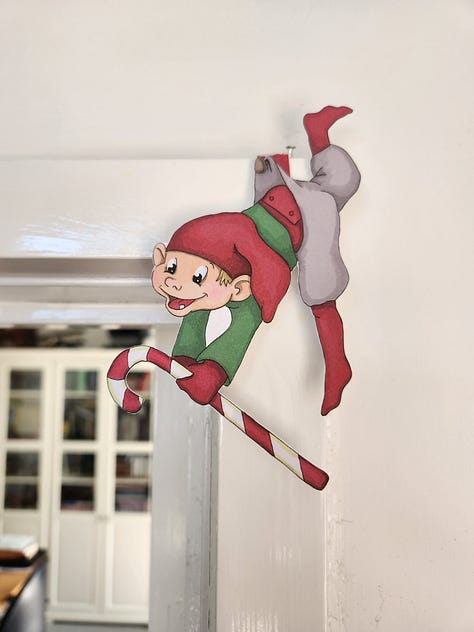
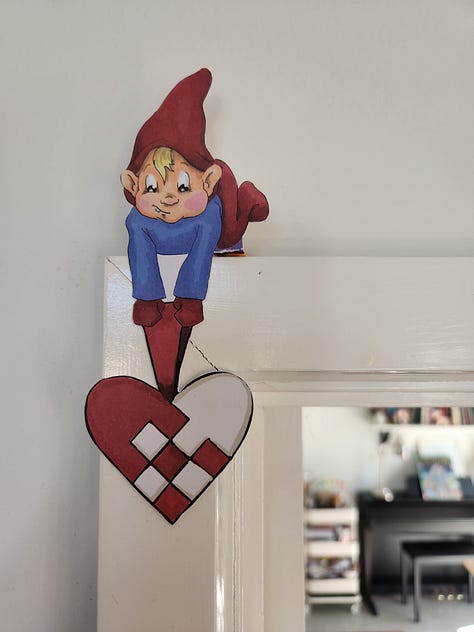

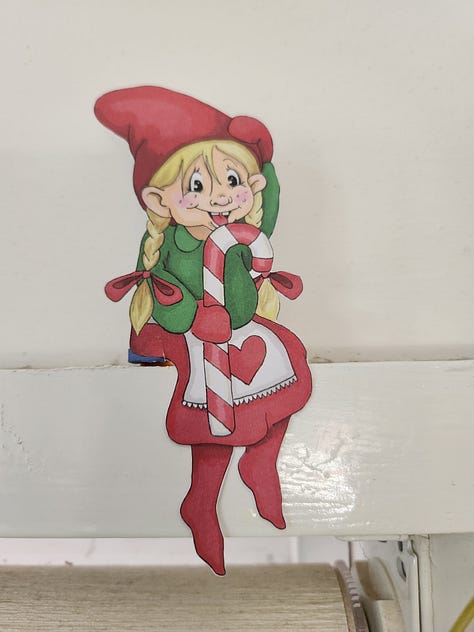
Julbok: The Yule Goat
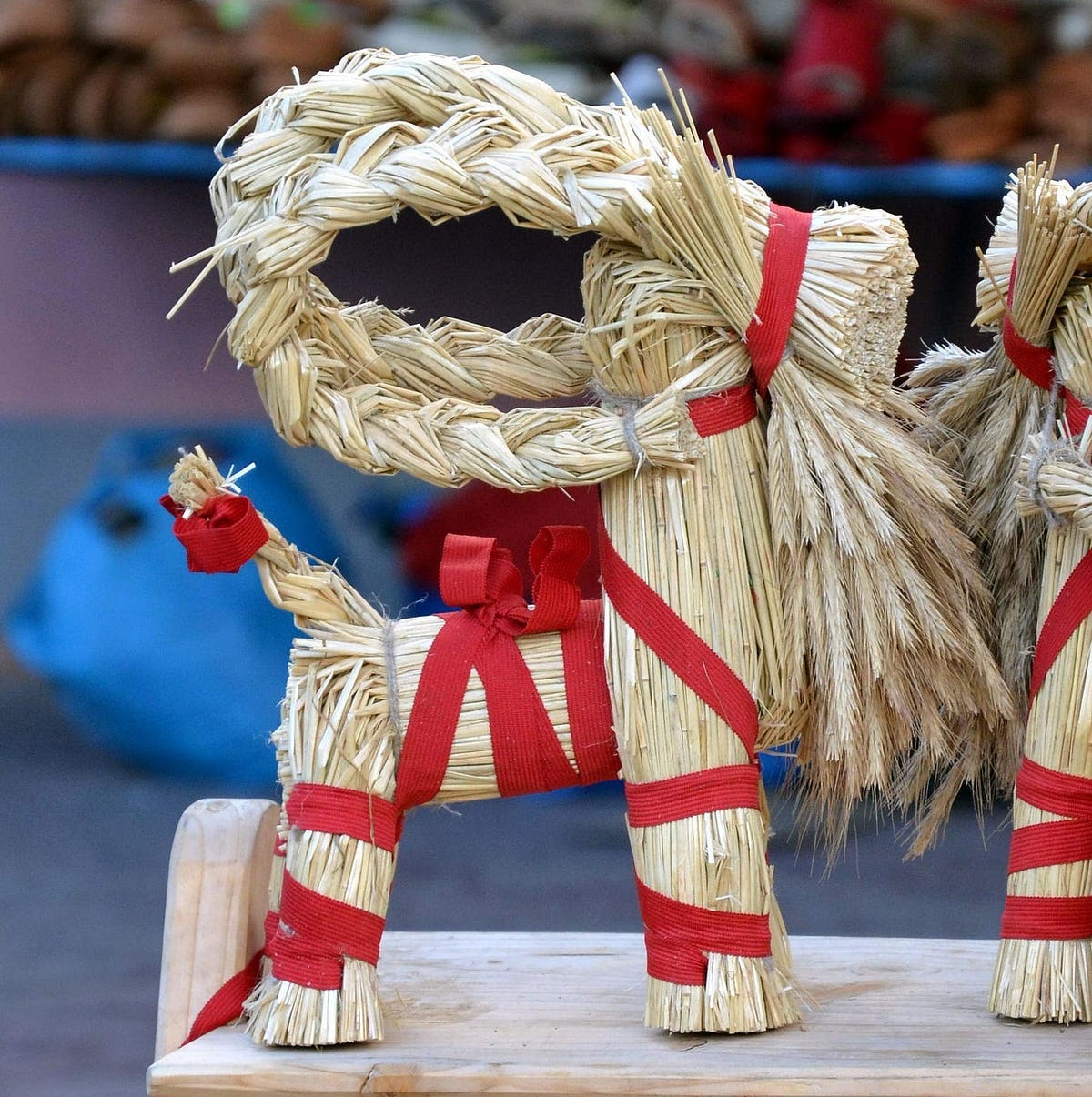
Another pre-Christian icon of the Scandinavian Yule season is the Julbok, also known as the Yule Goat. The Julbok was originally associated with the Norse god Thor whose chariot was pulled through the sky by two goats, Tanngrisnir (Toothgrinder) and Tanngnjóstr (Toothgnasher). These goats were said to have the magical ability to be slaughtered and then brought back to life the next day.
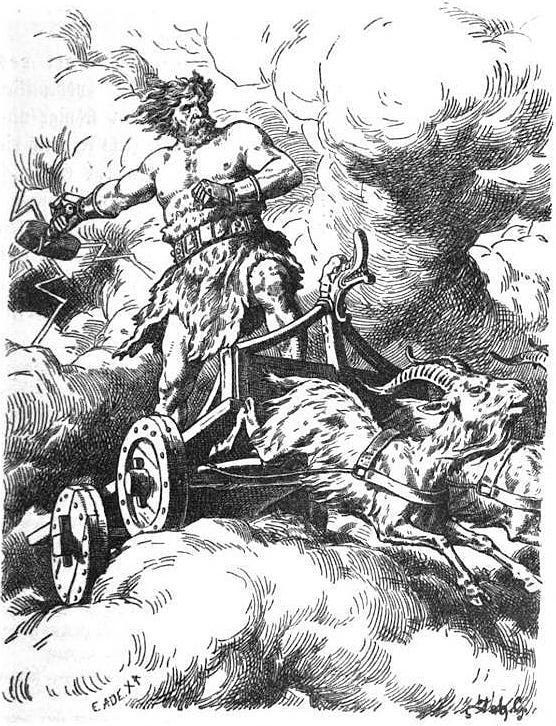
They are famously depicted in Marvel’s Thor Comic Book series and most recently in the movie based on these comics, Thor: God of Love and Thunder, as explained in the video (3:37 mins) below.
In old Norse farming communities, the last sheaf of harvested grain was kept aside for Yule celebrations, as it was believed to have magical properties, bringing abundance, fertility, and good fortune, and warding off evil spirits. This sheaf of grain was called Julbok, or Julebokken and was fashioned into the shape of a male goat often adorned with red ribbons, bells, and other decorations.

It was a common practice (and still is in some regions) for neighbours to prank each other by sneaking a Julbok into each other’s houses or sneaking the gifted one back without anyone noticing. From around the 17th century, in a tradition similar to the English mumming, guising, or wassailing, young men in costumes would go from door to door singing songs, acting out plays and performing pranks. One person in the group would dress as the Julbok and act particularly rowdy, demanding gifts and capering about.
A similar custom was practised in Eastern Europe, where the ancient proto-Slavic people honoured the god Devac (also known as Dazbog or Dažbog) during Koliada, the Slavic Yule/Winter festival. Devac was the god of the fertile sun and the harvest, represented by a white goat. A person dressed as a white goat demanding offerings is a key feature of many Koliada traditions.
In the 19th century, a new tradition developed where the Julbok became the Christmas gift-giver. One male family member dressed up as the Julbok and gave out gifts to other members of the family. However, this tradition was shortlived due to the increasing popularity of St. Nicholas and Santa Claus traditions from other parts of Europe. The Julbok as gift-giver was replaced by the jultomte or julenisse, (or the Finnish joulupukki), about which we will learn more in a future article, closer to the Christmas season.
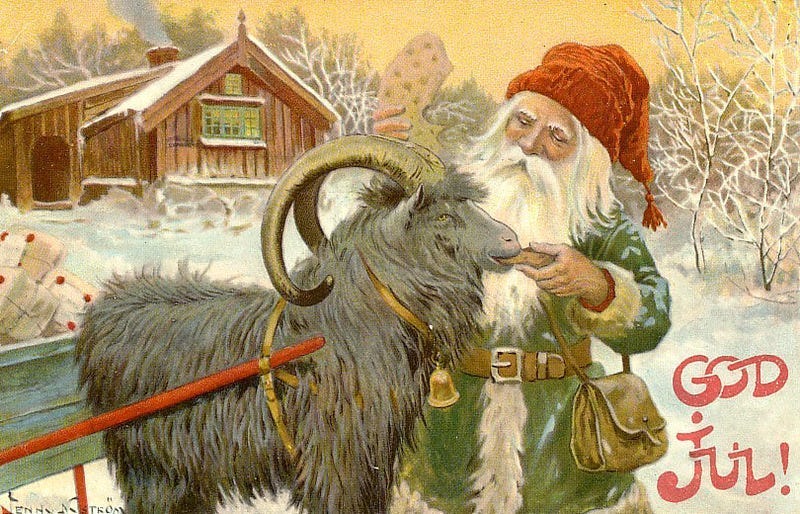
In 1966, the Swedish town of Gävle erected a large Julbok in the town square as an advertisement for the town. It was first constructed by the Gävle fire department, and then a group of businessmen known as the Southern Merchants (Söders Köpmän) financed the annual construction of the Gävle Goat. A second goat was erected by the Natural Science Club in 1971, and both organisations have competed against each other for the title of the largest (and handsomest) goat. Unfortunately, most of the Gävle Goats that have been built since 1966, have been damaged or completely destroyed by arsonists, despite concerted efforts to protect the goats, including security cameras, guards, and fire-proofing.

This lovely video (4:38 mins) by Swedish vlogger Juni Maria describes the tradition of the Julbok.
Yule Beasts: Grýla the Giant Troll, the Yule Lads and the Yule Cat

In addition to the joyful Yule characters of the Nisse/Tomte and Julbok, several rather more fearsome creatures feature in Icelandic Yule folklore. The Yule Troll or Christmas Witch called Grýla is a fearsome giantess with a grotesque appearance, hooves for feet and thirteen tails. According to legend, Grýla lives in a mountain cave in Iceland with her third husband, Leppalúði, their thirteen mischievous sons, known as the Yule Lads, and a giant and terrifying Yule Cat.
Grýla has an insatiable appetite for naughty children and during the Yule season in Iceland, which spans from December 12th to January 6th, she emerges from her cave, roaming the countryside to kidnap misbehaving children and take them back to her cave to cook in a large cauldron. The story of Grýla serves as a warning to Icelandic children to be on their best behaviour during the Yule season.
The Yule Lads

The Yule Lads, known as Jólasveinar in Icelandic, are Grýla’s thirteen mischievous sons. These naughty trolls start visiting children on the thirteen nights leading up to Yule, beginning on December 12th, and each one stays for a specific night before departing. The last one leaves on January 6th. During their visits, they place small gifts in well-behaved children’s shoes or play pranks on misbehaving children.
Each Yule Lad has his own distinct personality and peculiar behaviour, which has changed and evolved over time. The modern names and personalities of the Yule Lads were formalised in a popular poem about the Yule Lads by Jóhannes úr Kötlum, which was first published in the 1932 book Jólin koma (Yule Is Coming):
Stekkjarstaur (Sheep-Cote Clod) — He sucks the milk from sheep but is impaired in his mission by his two peg (wooden) legs.
Giljagaur (Gully Gawk) — He sneaks into cowsheds and steals milk.
Stúfur (Stubby) — He’s abnormally short and likes to steal pans to eat the crust left behind.
Þvörusleikir (Spoon-Licker) — He is tall and thin and steals wooden spoons to lick.
Pottasleikir (Pot-Scraper) — He licks the leftovers from pots and pans.
Askasleikir (Bowl-Licker) — He hides under beds, waiting for a chance to steal bowls of food.
Hurðaskellir (Door-Slammer) — He likes to slam doors in the middle of the night, scaring people.
Skyrgámur (Skyr-Gobbler) — He has an insatiable appetite for skyr (Icelandic yogurt).
Bjúgnakrækir (Sausage-Swiper) — He loves to hide in the rafters and steal sausages that are left unattended.
Gluggagægir (Window-Peeper) — He peeks through windows to see if there’s anything he can steal.
Gáttaþefur (Doorway-Sniffer) — He has a long nose that he uses to sniff out laufabrauð (leaf bread — you can find out more about laufabrauð in the article about Winter Feasts).
Ketkrókur (Meat-Hook) — He uses a hook to snatch any meat left out.
Kertasníkir (Candle-Stealer) — He follows children to steal their candles.
Over time, the Yule Lads’ reputation has softened, and they are now mostly known for their playful antics rather than outright terror. Icelandic families often incorporate them into their Christmas celebrations, and it has become a cherished tradition to receive small gifts or playful pranks from the Yule Lads during the holiday season.
The charming video (8:18 mins) below contains an English language reading of the poem Jólin koma (Yule Is Coming) by Jóhannes úr Kötlum, featuring the Yule Lads.
This next video (12:50 mins) is an interesting and in-depth look at the history of the Yule Lads, by ‘Ask an Expert’.
Jólakötturinn the Yule Cat
The Yule Cat, known as Jólakötturinn in Icelandic, is said to live with Grýla and the thirteen Yule Lads. It is a massive and fearsome grey and black striped cat with glowing eyes and sharp claws. It is said to prowl the countryside during the Yule season, particularly on Yule Eve, in search of people who have not received any new clothes to wear before Yule.

The legend of the Yule Cat has its roots in an old Icelandic tradition that encouraged hard work and rewarded those who contributed to the household’s welfare. In the past, it was believed that farmers who worked hard and produced a large quantity of wool throughout the year would be able to provide warm clothing for their families. Those who did not have new clothes to wear for Yule were considered lazy or unproductive.
To motivate people to work hard and complete their tasks before Yule, the threat of the Yule Cat was used as an incentive. This fear encouraged everyone, especially children, to finish their chores and contribute to the household’s prosperity by ensuring everyone had a new set of clothes for Yule.
Today, the Yule Cat remains a popular figure in Icelandic Yule folklore and is often featured in various forms of media, such as books, artwork, and decorations. The tradition of receiving new clothes for Yule has also evolved into a symbol of care and thoughtfulness towards loved ones, emphasizing the importance of giving gifts that are practical and meaningful.

The tradition of Grýla, the Yule Lads and the Yule Cat served to instil discipline and obedience in children. In modern Icelandic celebrations, the terrifying aspects of Grýla and the Yule Lads have been toned down and they are now a light-hearted and cherished part of Icelandic Yule folklore. Except for the Yule Cat, who is still a terrifying prospect for those without new clothes for Yule.
I hope you enjoyed this short exploration of the iconic creatures of Scandinavian Yule folklore. Next week, we will dive into the last of the winter and Christmas/Yule-themed topics, looking at the folklore and traditions surrounding two little birds, the robin and the wren.





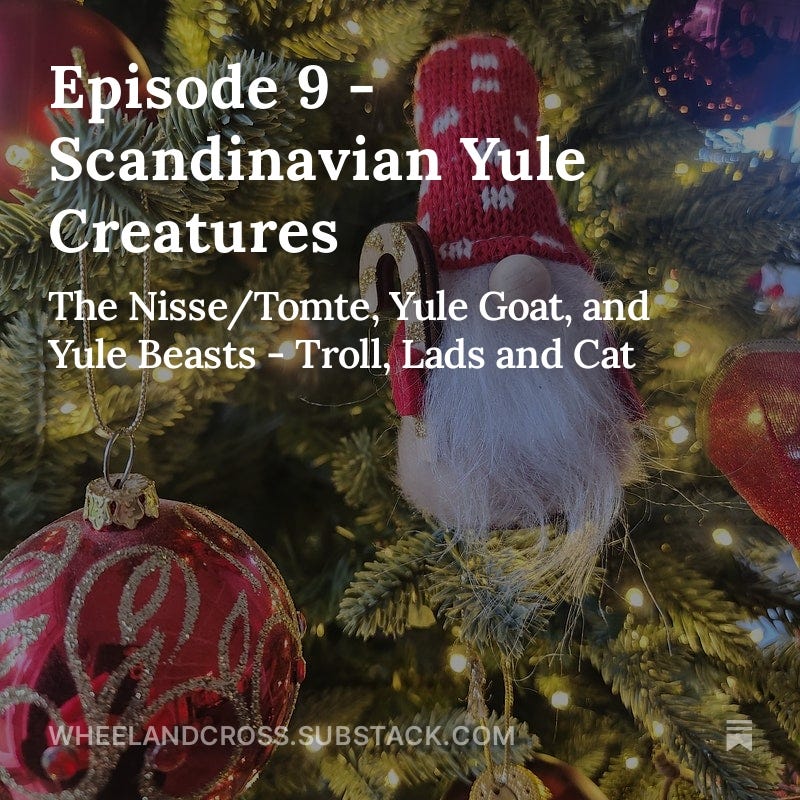









Share this post